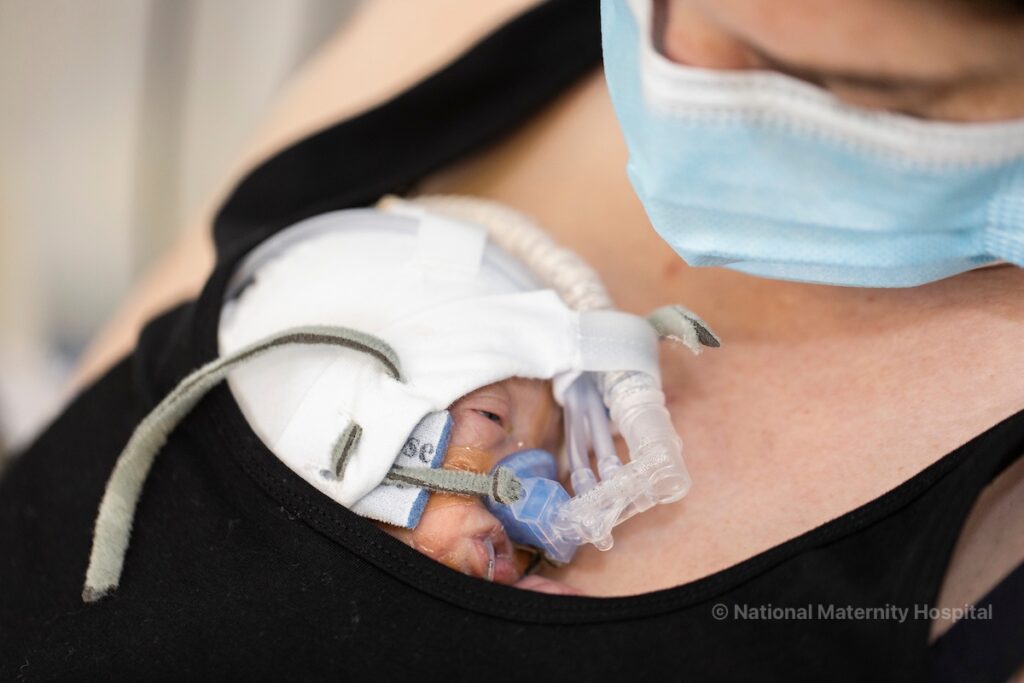In the NICU - Caring for baby
Comfort activities
Benefits of ‘Comfort Care’ measures
- Helps bonding, attachment and positive interaction between you and your baby.
- Helps steady your baby’s heartbeat, breathing and body temperature.
- Helps promote your baby’s sleep, which is important for their brain development.
- Helps conserve your baby’s energy and improve their growth and feeding.
- Helps stimulate and increase breast milk supply, preparing mothers for breastfeeding.
- Helps build your sense of wellbeing and self-confidence as a parent.
Remember to watch your baby to learn from them what comfort measure to use and when it is appropriate, safe and pleasurable for him, see ‘Interacting with your baby’. Ask your baby’s nurse to guide you.
Talk, Sing and Read to Your Baby
We know that babies love and respond well to their parents’ voice. When your baby was inside you, they got to know your voice. Hearing your voice while in the neonatal unit will be very reassuring and comforting for your baby.
Your baby is listening when you are talking, reading, or singing. Tell them about your day, sing nursery rhymes, read baby books, or tell them stories. Your voice is unique. Chatting to your baby in this way is important for their brain and language development.
Watch your baby’s cues as you speak, sing, or read to them. If it is too much for your baby to engage with you, they will show you. At the beginning, use one sense at a time – your voice on its own. When your baby is comfortable with your voice, try using your voice and eye contact or voice and touch together and wait for your baby to respond. Turn taking in your conversations with your baby gives your baby a sense that they are important to you. Your baby’s voice might be at first non-verbal through a movement of a hand, foot, arm, leg, flicker of an eye, mouth or through showing a more relaxed posture. As your baby develops, they will become more vocal. We know that infant vocal expressions greatly increase between 32-36 weeks. When a parent is present, infants make significantly more vocal expressions.
If you live in a bilingual or multilingual household, it does not mean you have to stick to one language only. Babies recognize the tone of your voice and the way you speak. They will start getting used to the different sounds that will enrich their daily life.
Music therapy in the neonatal unit.
Research on music therapy use in the neonatal unit is ongoing. While it is showing some promising results, it is not yet an established therapy. It is good for parents to sing to their babies on the neonatal unit.
Eye Contact
Face your baby and look into their eyes when they are awake. Eye contact requires effort for your baby, so they may only be able to do this for a short time.

Gentle Touch
Gentle Touch is a way of communicating love and reassurance to your baby. It is a very rewarding experience for you both.
Your first touch may be to put your finger near your baby’s hand – they may just like to feel your touch, or they may hold your finger.
Remember, do not use light feathery stroking movements as babies may find this ticklish and irritating.

Mum engaging in Gentle Touch with her baby
Comfort Hold (Containment Hold)
Comfort Hold can help your baby to feel secure and relaxed. A gentle, still handhold can be very soothing.
How to do Comfort Hold
- Cup your warm hand around your baby’s head and/or feet.
- If your baby is in lying on their tummy (prone position), gently rest your other hand around your baby’s shoulders
- If your baby is lying on their back (supine position) gently cross their arms over their chest. Alternatively, wrap a sheet around their arms and shoulders.
- It helps if you breathe slowly and deeply with a feeling of relaxation in your hands.
- Continue to Comfort Hold until your baby feels settled.
- To finish Comfort Hold, slowly take away one hand, and if your baby remains settled, take away your other hand.

Mum doing Comfort Hold with her baby
When is a good time to Comfort Hold my baby?
- During and after caregiving, medical or nursing procedures, e.g. after taking a blood test.
- For pain relief.
- When your baby looks unsettled.
Did You Know?
For pain relief, babies may be offered tastes of a sucrose (sugar) solution to suck.
Kangaroo Care (KC)
KC involves holding your baby ‘skin-to-skin’, in a ‘kangaroo style’ on your chest. Your baby can rest, sleep or feed in this position. Stable babies on breathing support (e.g. ventilator/CPAP) can also enjoy KC.
KC is generally not started just after feeds, as babies may be uncomfortable being moved if their tummy is full of feed. Your baby can generally be fed during KC, when they are already in a KC position.
Ask your baby’s nurse when a good time is for KC.
“Kangaroo Care helps bonding, attachment and positive interaction between you and your baby”

Mum doing Kangaroo Care with her baby
How to do Kangaroo Care (KC)
- Wear a light comfortable front opening top. When your baby is stable, they can be tucked inside your top.
- Keep your baby warm by using a soft blanket and a hat if needed.
- Cup one hand under your baby’s head and place your other hand around their hips.
- Gently lift your baby onto your chest.
- Rest their head against your breastbone.
- Support their back and bottom with your hands.
- If your baby is in a nest in an incubator, you can lift them out on their nest.
- While you are becoming comfortable with KC, your partner or your baby’s Nurse may help to position your baby on your chest.
- Change the side to which you position your baby’s head each time you do KC to help your baby’s muscles develop equally on both sides.
- You can do KC with your baby at home too.
Positive oral (mouth) experiences
Preterm babies can have many medical procedures in the neonatal unit that are not nice around their face and mouth, e.g. intubation, ventilation, suctioning and tube feeding. As a result, your baby may learn that the mouth is not a nice place. This can be a particular issue for babies who are not able to feed by mouth (oral feeds) and do not get to enjoy feeding by mouth.
To help protect against this and help the development of your baby’s oral skills and feeding, offer your baby positive oral experiences when they are able to tolerate handling and touch to their face.
Positive oral (mouth) experiences to help develop your baby’s oral and feeding skills
- Encourage non-nutritive sucking (NNS), see ‘Non-nutritive sucking’.
- For Mums, hold your baby skin-to-skin.
- Offer your breast to lick and suck. This provides positive oral experiences in a lovely natural way.
- If your baby is unable to safely suck and swallow, offer your ‘empty’ breast, i.e. after you have expressed milk, so that there is no milk for your baby to attempt to suck.
- Offer gentle mouth-care, see ‘Mouth-care’.
- Expose your baby to pleasurable smells and tastes, e.g. tastes of their milk feeds during NNS.
- Avoid unpleasant smells and tastes.
- Ensure that tube-feeds are comfortable; see ‘Tube-feeding’.
- Ensure that oral feeds (by mouth) are pleasurable and do not cause your baby any distress, see ‘Oral feeding’.
Non-nutritive sucking (NNS)
Sucking is a natural behaviour that babies enjoy. Non-nutritive sucking means sucking that is not for feeding. NNS includes sucking a mother’s empty breast, a soother, a finger or a cotton bud swab rather than when your baby is sucking to feed.
NNS has a special role in the care of babies who are unable to feed by mouth, for example:
- NNS helps promote positive oral (mouth) experiences that help develop your baby’s oral and feeding skills, see ‘Positive oral experiences’ LINK.
- NNS during tube-feeds helps your baby to associate pleasurable sucking with feeding.
- NNS helps stimulate digestion.
- NNS can be comforting for your baby during medical procedures.
Did You Know?
For Mums, holding your baby close to your breast will also help to stimulate your milk supply.
How to provide NNS for your baby:
- Support your baby to bring their hands to their mouth and suck their own fingers.
- For Mums, offer your empty breast to suck.
- Offer an appropriate size soother to suck.
- Soothers have a useful role in NNS.
- Your baby may like to taste some milk during NNS, for example:
– small tastes of expressed milk during skin-to-skin at your breast or
– a cotton bud swab or their soother dipped in their milk feed.
Ask your baby’s nurse for guidance.
“NNS and providing your baby with the taste of their milk feeds during tube-feeds can help them to associate this pleasurable sucking and taste with feeding.”
Being able to suck does not mean that your baby is ready to feed by mouth. Your baby is only ready for oral feeds when they are mature and well enough to safely co-ordinate sucking, swallowing and breathing, see Oral feeding.







